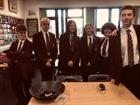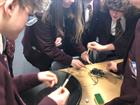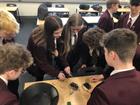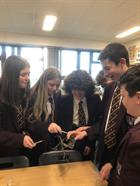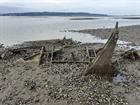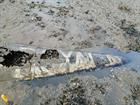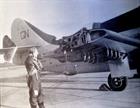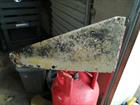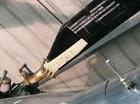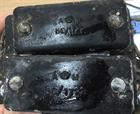School Pupils research history of 1958 Royal Navy helicopter crash in NI
School Pupils research history of 1958 Royal Navy helicopter crash in Northern Ireland
A dedicated team of junior pupils from Foyle College in Londonderry, Northern Ireland have been researching the history of a Royal Navy Dragonfly helicopter that crashed in Lough Foyle in 1958. The helicopter was based at the Royal Naval Air Station Eglinton.
The college has a great track record of working on various licensed aviation archaeology projects, including a Battle of Britain Spitfire, a USAAF P38 Lightnings and most recently, a Coastal Command Beaufort. The latest recruits into the Foyle College Aviation Team (FCATs) take up the story
“We were inducted into the FCATS in 2021 and our first mission was to excavate a 19th century midden associated with an old church rectory. We recovered many ink wells, mineral water bottles, medicine bottles, and many shards of pottery. We learnt how to survey a site and use ground penetrating radar to find out what lies beneath. But we also really wanted to work on something aviation related!
We were excited to be approached by our Geology teacher Ms Sloane with a new project. Aviation archaeologist Jonny McNee who was a former pupil at the school, had recently been helping his work colleagues in the Department of Agriculture, Environment and Rural Affairs to identify mysterious wreckage that was slowly emerging from the middle of Lough Foyle.
He presented us with some smelly little plastic looking boxes that were encrusted in barnacles and asked could we clean them and carefully look over them for part numbers that might identify the parts or the wreckage. The parts were all found in the engine compartment area. Jonny also left us many photos of the wreckage and told us to do our best and see what we find out.
The black boxes were 10 x 3cms in size and had 5 wires coming out each of them. They were absolutely covered in barnacles. We carefully scraped and sometimes gently hammered to get all the barnacles off. It felt like they were cemented on!
Slowly, some part numbers emerged. We could read AM SC/1722. We went on line and found out these were Air Ministry Universal 12 volt Cut Out Switches SC/1722. Looking at the photos, especially the overall shape of the fuselage and the bit that looks like a leg sticking up, we were soon confident that this was a helicopter and an early one at that.
We then researched all the Royal Navy helicopter losses and we found out that a Westland Dragonfly had crashed in this area in 1958 while trying to lift parts of a plane that fallen off while it was firing rockets. Jonny told us that the remains did lie in a rocket range so we knew we had the right helicopter!
Jonny later sent us close-ups of the site when he and a work colleague rowed out to the wreckage. We were able to identify all the key parts of the Dragonfly which now lies on its starboard side. We could see the outline of the cabin very clearly, the engine bay, the rotor blades and the tail boom which still has the words ‘Royal Navy’ clearly visible down its length.
Further checks with the Fleet Air Arm Museum at Yeovilton confirmed this was HR.5 WN498 which crashed on the 25th November 1958. The crew of two (Lieutenant Commander Eric J ‘Porky’ Meadowcroft and his winch man) were shaken but unhurt in the incident. They had been trying to lift the wing tips of a Gannet aircraft that had sheared off during an earlier exercise over the rocket range.
As they were lifting them the winchman cut the cable unexpectedly and the helicopter rolled over onto its starboard side. At low altitude it had no room to recover and it struck the surface of Lough Foyle. The crew walked out of the wreckage and were wading back to shore when they were picked up by a rescue boat.
With some research, we discovered 72 dragonfly helicopters entered active service with the Navy and the one that crashed on the shores of lough Foyle was actually a naval air-sea search and rescue helicopter which at that time (1958) was stationed in the Royal Naval Air Station at Eglinton. We also found out that the replacement Dragonfly sent from RNAS Donibristle in Scotland to replace WN498 ditched two weeks later into the sea near Eglinton! Thankfully the crew of this helicopter were also rescued
The MK 5 was the ‘first helicopter produced by Westland. The Dragonfly was built under licence from Sikorsky and used by the Royal Navy for Search and Rescue. The major customer was the Royal Navy who saw the helicopter as ideal for plane guard duties aboard the aircraft carriers and for Search and Rescue work and other duties. The Dragonfly was used in the SAR and training role and eventually served for some 15 years before being retired in the mid-1960s
We also managed to find 2 photos of a very relieved Lieutenant Eric Taylor back at Eglinton with his Gannet but without his wingtips!
We have really enjoyed our research and we would love to hear if any members of the Fleet Air Arm Officers Association remember this crash, or Lt Cmdr Meadowcroft or Lt Taylor. We would also like to hear from anyone who could tell us of their Navy time at Eglinton so we can include their stories in our scrapbook.
Thank you for reading our story and we hope you enjoy the pictures.
Best wishes
The FCATs
A Westland Dragonfly
The wreck of WN498 discovered near Lough Foyle (DAERA)
Port rear undercarriage leg of the Dragonfly (DAERA)
‘Royal Navy’ still clearly visibly on the tail boom. (DAERA)
A relieved Lt Taylor (719 Naval Air Squadron) having landed safely back at Eglinton.
“They were there when I took off!”
Another cleaned up piece recovered from the site (DAERA)
Here is the same part on a preserved Dragonfly at Yeovilton (Dave Morris)
The Air Ministry Universal 12 volt Cut Out Switches (SC/1722) that we cleaned


